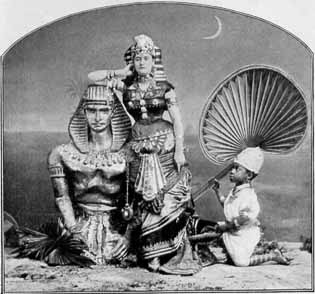
The year was 1875. As reported in The Cosmopolitan (for January, 1898), the governor of New York proposed a fund raiser for the expected visitors in the upcoming American centennial celebrations. New York City’s high society was mobilized under the direction of Mrs. Elizabeth Hamilton Cullen, granddauther of Alexander Hamilton and wife of General G. W. Cullen. Mrs. John Jacob Astor and Mrs. Belmont assisted in gathering 230 elite ladies and gentlemen to pose in various tableaux from “The Puritan Family at Prayer†to “Miss Egypt†shown here. Here is a nostalgic tidbit of vintage American Orientalism when the digs in Egypt were still very fresh. But for a nation that had only abolished slavery slightly over a decade before, it is clear that the race to end racism had only just begun.
One shining star of this cultural scene was Miss Minnie Stevens, described in the articles as being in “the very morning of her charms.â€
“She appeared as Cleopatra. Her dress was of black, banded in the true spirit of Egyptian ornamentation with wasp-like cross-wise stripes of gold. On her head she wore the adornment sacred to the goddess Neit and adopted by Cleopatra.
“Miss Stevens had provided her tableau with a Sphinx (borrowed from the opera) and a little negro boy, who held a fan over her head. After the tremendous applause that greeted this reproduction of Egypt’s last queen, everybody began to laugh. It would have disconcerted one less calm or more self-conscious than Miss Stevens. The disturbing cause proved to be the eyes of the little negro attendant. They were rolling fearfully, and their whites against the portentous black of the face seemed two mere holes, which as his eyes moved, changed place with lightning rapidity. It was indescribably funny. That may illustrate the many unforeseen and unpreventable accidents of tableau-giving.
“There is a pagan element in us that does not entirely die out through we build altars to a nobler faith. We are the same human beings as those who on the banks of the Nile watched moon and stars and evening sky and drew from them the hope and the despair of life. The Egyptian mythology attracted us greatly, and so we had two ‘Egypts.’ The second represented Thaut, the mother, goddess of the deep violet evening sky, tenderly brooding over the hot, exhausted earth when the day is over, and inviting all to rest. Mrs. Eldredge, who impersonated this idea for us, had spent considerable time in Egypt. she was, too, a daughter of Peter Parley, and had a right to know everything! To her we owed most of our Egyptology. When I shall pitch my moving tent upon the banks of the old Nile, I shall see, I am sure, that unforgetable vision, just as she sat that night in her boat, clad in deep violent draperies, with all the Oriental magnificence if Egyptian chains and bracelets, and wearing the crown of Hathor, goddess of love. It was a tableaux at once so learned, so expressive and so comprehensive that for the moment we felt transported to another world.â€
[Excerpted from M. E. W. Sherwood, “Some Society Tableaux,†The Cosmopolitan 24:3:240-241, 1898. ]